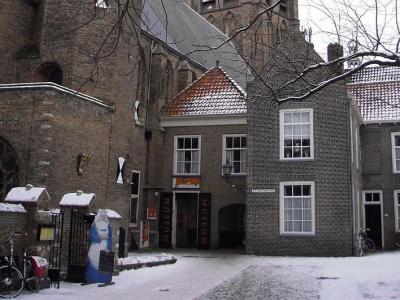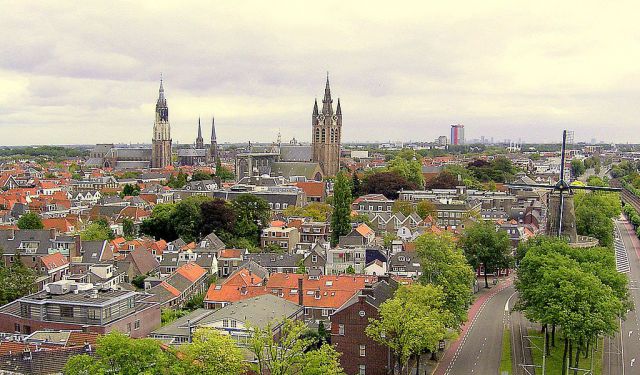Museum Het Prinsenhof (Court of the Prince Museum), Delft (must see)
The Court of the Prince, known locally as Prinsenhof, began in 1403 as the Catholic monastery of Saint Agatha. The monastery became one of the wealthiest and largest monasteries of Delft. At one time as many as 125 nuns lived in the monastery complex. In 1572 the Protestant Reformation upended things and the monastery was seized and awarded to William of Orange and his forces.
William used part of the Prinsenhof as a residence. He was actively at war with Spanish elements in the lowlands. The King of Spain had posted rewards for his head. On 10 July, 1584, William was shot and killed in the Prinsenhof by Bathasar Gerards. Two bullets went through his body and lodged in the wall. The holes can still be seen today.
The architecture of the monastery is preserved on the ground floor of the museum. There is a collection of paintings that resonate with the religious upheavals that shaped the country. The second floor houses a display of the city's history. The art collection is prized for its paintings of the great masters of the Netherlands' Golden Age of Art.
The museum at Prinsenhof holds collections grounded in three areas: William the Silent, Delft Masters and Delftware, porcelain masterpieces ("Delft Blues"). The production of Delftware was inspired by the "blue-white" porcelain imported from China. It was developed by copying the Chinese techniques.
In 1908 the museum started amassing its vast collection of Delftware. There are more than 3,300 pieces illustrating stages of Dutch history. In the 1960s the museum acquired vases and flower holders that were once in the collection of Queen Mary, wife of William III. The vases were made by "the Greek A" factory of Delft in the 1690s.
After the assassination of William, the Prinsenhof was donated to the city. It formally became a museum in 1887. Between 1880 and 1940 there occurred what is popularly called the "Miracle of Delft." It was a combining of art, science and industry. The museum tells this story with Art Nouveau posters, pottery, and stained glass.
William used part of the Prinsenhof as a residence. He was actively at war with Spanish elements in the lowlands. The King of Spain had posted rewards for his head. On 10 July, 1584, William was shot and killed in the Prinsenhof by Bathasar Gerards. Two bullets went through his body and lodged in the wall. The holes can still be seen today.
The architecture of the monastery is preserved on the ground floor of the museum. There is a collection of paintings that resonate with the religious upheavals that shaped the country. The second floor houses a display of the city's history. The art collection is prized for its paintings of the great masters of the Netherlands' Golden Age of Art.
The museum at Prinsenhof holds collections grounded in three areas: William the Silent, Delft Masters and Delftware, porcelain masterpieces ("Delft Blues"). The production of Delftware was inspired by the "blue-white" porcelain imported from China. It was developed by copying the Chinese techniques.
In 1908 the museum started amassing its vast collection of Delftware. There are more than 3,300 pieces illustrating stages of Dutch history. In the 1960s the museum acquired vases and flower holders that were once in the collection of Queen Mary, wife of William III. The vases were made by "the Greek A" factory of Delft in the 1690s.
After the assassination of William, the Prinsenhof was donated to the city. It formally became a museum in 1887. Between 1880 and 1940 there occurred what is popularly called the "Miracle of Delft." It was a combining of art, science and industry. The museum tells this story with Art Nouveau posters, pottery, and stained glass.
Want to visit this sight? Check out these Self-Guided Walking Tours in Delft. Alternatively, you can download the mobile app "GPSmyCity: Walks in 1K+ Cities" from Apple App Store or Google Play Store. The app turns your mobile device to a personal tour guide and it works offline, so no data plan is needed when traveling abroad.
Museum Het Prinsenhof (Court of the Prince Museum) on Map
Sight Name: Museum Het Prinsenhof (Court of the Prince Museum)
Sight Location: Delft, Netherlands (See walking tours in Delft)
Sight Type: Museum/Gallery
Guide(s) Containing This Sight:
Sight Location: Delft, Netherlands (See walking tours in Delft)
Sight Type: Museum/Gallery
Guide(s) Containing This Sight:
Walking Tours in Delft, Netherlands
Create Your Own Walk in Delft
Creating your own self-guided walk in Delft is easy and fun. Choose the city attractions that you want to see and a walk route map will be created just for you. You can even set your hotel as the start point of the walk.
Johannes Vermeer's Delft Walk
The Dutch painter Johannes Vermeer (1632 – 1675) spent almost his entire life in his home town, Delft. He left only a few times, towards the end, on the short trips to Amsterdam and The Hague.
The old Delft undoubtedly was one of the most typical little towns of the 17th-century Netherlands, and as such, was rather picturesque. Just like any other Dutch place, Delft was dominated by its... view more
Tour Duration: 1 Hour(s)
Travel Distance: 2.0 Km or 1.2 Miles
The old Delft undoubtedly was one of the most typical little towns of the 17th-century Netherlands, and as such, was rather picturesque. Just like any other Dutch place, Delft was dominated by its... view more
Tour Duration: 1 Hour(s)
Travel Distance: 2.0 Km or 1.2 Miles
Delft Introduction Walking Tour
The word "delven" in Dutch means "to dig." The town of Delft began in 1075 when a nobleman decided to build his dream manor where a canal crossed the silted up river Gantel. A settlement became a market town with a large market square. The town was called "Delft."
Canals were vital to Delft. Flat-bottomed boats brought in products, fuel and people. In 1246 Count... view more
Tour Duration: 2 Hour(s)
Travel Distance: 2.0 Km or 1.2 Miles
Canals were vital to Delft. Flat-bottomed boats brought in products, fuel and people. In 1246 Count... view more
Tour Duration: 2 Hour(s)
Travel Distance: 2.0 Km or 1.2 Miles





